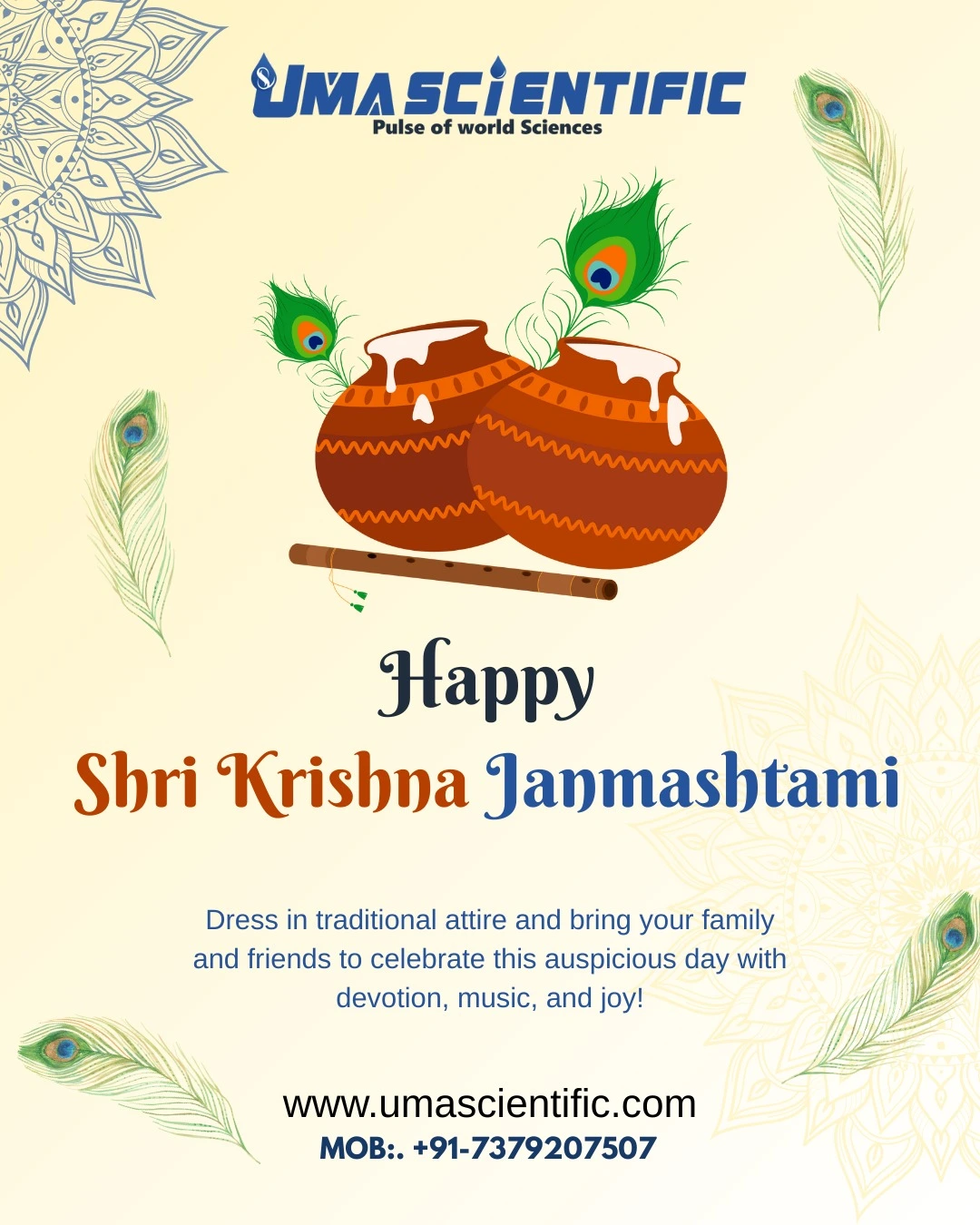Unveiling the Essence of Krishna Janmashtami 2025: Why, When, and How We Celebrate Uma Scientific, proudly headquartered in Lucknow, Uttar Pradesh, extends its warmest Krishna Janmashtami greetings to all! This revered Hindu festival commemorates the birth of Lord Krishna, the eighth incarnation of Vishnu, embodying love, wisdom, and the eternal victory of righteousness over malevolence. As a premier ‘Made in India’ manufacturer of cutting-edge laboratory instruments, Uma Scientific embraces this cultural celebration, merging spiritual reverence with scientific excellence.
why we celebrate Krishna Janmashtami, when its traditions originated, and how it is joyously observed, delving into its rich historical backdrop, profound spiritual meaning, diverse regional expressions, and contemporary practices. We’ll also explore how this festival fosters unity and inspires progress, concluding with a special acknowledgment of Uma Scientific’s contribution to India’s scientific heritage.
Why Do We Celebrate Krishna Janmashtami?
Krishna Janmashtami is a festival steeped in divine significance and human aspiration, celebrating the life and legacy of Lord Krishna. The “why” behind this observance is a tapestry of spiritual, historical, and cultural threads that continue to resonate today.
The Divine Narrative
Lord Krishna’s birth, detailed in the Bhagavata Purana, occurred over 5,000 years ago in the confines of a Mathura prison. Born to Devaki and Vasudeva, Krishna was the eighth child destined to overthrow his uncle, King Kansa, who had imprisoned his parents to prevent this prophecy. Kansa’s slaughter of Devaki’s first six children heightened the drama, but Krishna’s miraculous escape—carried by Vasudeva across the flooded Yamuna to Gokul, where he was raised by Yashoda and Nanda—set the stage for his divine mission. His eventual triumph over Kansa symbolizes the power of good to prevail, a core reason for the festival.
Spiritual and Philosophical Depth
Krishna’s life offers a wealth of spiritual guidance. The Bhagavad Gita, his discourse to Arjuna during the Mahabharata war, imparts lessons on dharma (duty), bhakti (devotion), and nishkama karma (selfless action). These teachings encourage devotees to navigate life’s challenges with grace and purpose. Janmashtami becomes a moment to internalize these values, seeking inner peace and strength. His childhood leelas—stealing butter, dancing with gopis—add a layer of joy, making him a relatable deity whose playfulness inspires love and laughter.
Cultural and Social Resonance
The festival unites India’s diverse population, transcending caste, creed, and region. It reinforces cultural values such as community, hospitality, and the celebration of innocence, as seen in Krishna’s early years. Historically, it has been a platform for cultural preservation, with Mathura and Vrindavan emerging as pilgrimage centers that boost local economies. In modern India, it’s a day to honor the legacy of Bhakti saints like Mirabai and Tulsidas, who spread Krishna’s devotion, and to inspire patriotism, especially as it follows Independence Day 2025.
When Did Krishna Janmashtami Begin?
The “when” of Krishna Janmashtami traces its origins to ancient scriptures and evolves through historical epochs, offering a glimpse into its enduring legacy.
Mythological Origins
The Bhagavata Purana and Vishnu Purana place Krishna’s birth in 3100 BCE, during the Dwapara Yuga, a time marked by the Mahabharata. This event is dated to the Ashtami Tithi of Krishna Paksha in Bhadrapada, under the Rohini Nakshatra, with specific planetary alignments—Jupiter in Cancer, Saturn in Libra—still referenced by astrologers. This celestial precision underscores the festival’s spiritual timing, observed annually based on the lunar calendar.
Historical Development
Historical records suggest organized celebrations began during the Gupta Empire (4th-6th century CE), a period of Hindu renaissance. Inscriptions from Mathura indicate early temple worship of Krishna, including birth anniversaries. The Bhakti movement (12th-16th century), led by figures like Chaitanya Mahaprabhu and poets like Surdas, amplified its reach, integrating it into folk traditions. During the Mughal era, rulers like Akbar participated in Mathura’s festivities, blending cultures. The British period saw it as a resistance tool, with communities asserting identity, and post-1947, it gained official recognition.
2025 Context
In 2025, Krishna Janmashtami spans August 15-16, with the Ashtami Tithi from 3:39 AM on August 15 to 2:19 AM on August 16. This overlap with Independence Day’s aftermath enhances its significance, linking spiritual liberation with national freedom, a theme Uma Scientific echoes with its self-reliant products.
How Is Krishna Janmashtami Celebrated?
The “how” of Krishna Janmashtami is a vibrant celebration of faith, tradition, and community, unfolding over days with regional flair and modern adaptations.
Preparatory Rituals
Preparations start early:
- Decoration: Homes and temples are festooned with marigolds, mango leaves, and rangolis. Jhulan swings, adorned with flowers, cradle Krishna idols.
- Fasting: Devotees observe Nirjala (waterless) or phalahaar (fruit-based) fasts, culminating in midnight offerings.
- Shopping: Markets in cities like Mathura and Lucknow buzz with purchases of clothes, sweets (makhan, peda), and puja items.
Core Ceremonies
The festival peaks with:
- Midnight Aarti: At midnight, temples resound with bells and conch shells. Priests perform abhishekam, bathing idols with milk, honey, and curd, followed by dressing them in new attire.
- Dahi Handi: Maharashtra’s iconic event sees Govinda teams building pyramids to break curd-filled pots, echoing Krishna’s mischief, with prizes adding thrill.
- Ras Leela: Mathura and Vrindavan host dance dramas depicting Krishna’s love with Radha, drawing pilgrims worldwide.
- Bhajans and Kirtans: Chanting “Hare Krishna” and singing devotional songs create a spiritual ambiance.
Regional Celebrations
India’s diversity shines:
- Uttar Pradesh (Mathura-Vrindavan): A week-long fair with non-stop Gita recitations and illuminated temples.
- Maharashtra: Dahi Handi competitions, now with safety regulations, are a public spectacle.
- Gujarat: Garba and dandiya dances complement temple rituals.
- South India: Tamil Nadu’s kolam designs and Kerala’s Krishna processions stand out.
- ISKCON Globally: 24-hour kirtans and prasad distribution unite devotees.
Modern and Inclusive Practices
In 2025, celebrations adapt:
- Digital Engagement: Live temple streams and #KrishnaJanmashtami2025 trends on social media.
- Charity: Food drives and health camps reflect Krishna’s compassion.
- School Events: Children dress as Krishna, supported by lab-equipped schools like those using Uma Scientific tools.
Security measures ensure safety, especially at pilgrimage sites.
In-Depth Celebration Insights
Pre-Festival Buzz
Days before, households clean thoroughly, symbolizing purity. Women prepare fasting foods like sabudana khichdi and sing bhajans, while men organize community events. Markets in Lucknow see a surge in traditional attire sales.
Midnight Vigil Details
The midnight vigil is a spiritual peak. Temples like Banke Bihari see lakhs of devotees, with priests narrating Krishna’s birth. Families light diyas, offer butter, and pray, creating a serene yet festive mood.
Post-Midnight Joy
Post-midnight, fasts break with prasad. Children break matkis, and urban areas host cultural shows. In rural settings, village panchayats organize simple feasts, fostering community bonds.
Regional Nuances
- North: Mathura’s fair is a UNESCO heritage event.
- West: Mumbai’s Dahi Handi draws global attention.
- East: ISKCON Kolkata hosts international gatherings.
- South: Andhra’s Krishna temples see massive crowds.
Adaptation and Inclusivity
Eco-friendly decorations, virtual pujas for the elderly, and interfaith participation reflect Krishna’s universal message, aligning with 2025’s progressive spirit.
Significance in 2025
In 2025, Krishna Janmashtami’s timing post-Independence Day amplifies its theme of liberation. It’s a call for self-reliance—spiritual and national—mirrored by Uma Scientific’s indigenous lab innovations.

Uma Scientific: A Celebration of Precision and Pride
As Krishna Janmashtami 2025 unfolds, Uma Scientific, Lucknow’s scientific pride, joins the festivities. We craft micropipettes (5µL-1000µL), autoclavable and ISO 9001-compliant, empowering research and education. Our OEM options embody the craftsmanship Krishna inspires. Visit www.umascientific.com or call +91-7379207507. Happy Janmashtami from Uma Scientific!

Hashtags: #KrishnaJanmashtami2025 #UmaScientific #MadeInIndia #KrishnaDevotion #IndianFestivals #LabInstruments #Micropipettes






